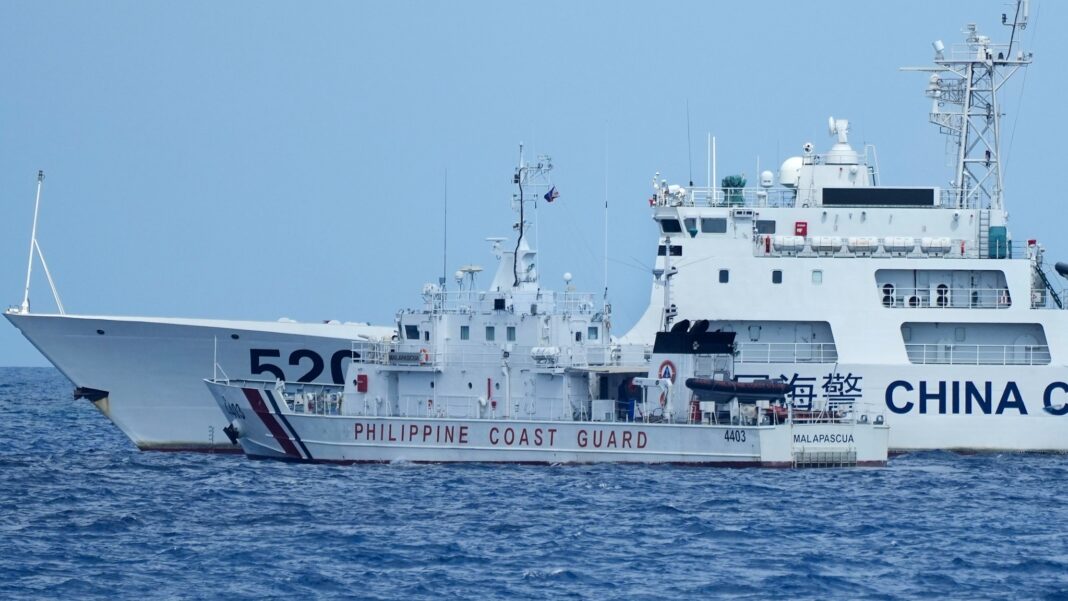The U.S. is prepared to assist the Philippines as China interferes with Manila’s efforts to resupply a grounded naval ship in the South China Sea, said Adm. Samuel Paparo, commander of the U.S. Pacific Fleet, vowing to curb Beijing’s maritime provocations.
China has “frequently interfered with those resupplies,” and these acts are “clearly unlawful,” Paparo told Nikkei in an online interview Friday, referring to the China Coast Guard’s aggressive maneuvers around the BRP Sierra Madre in Ayungin Shoal, also known as Second Thomas Shoal.
Manila runs supply missions for a small military contingent aboard the World War II-era U.S. vessel, which was intentionally grounded in 1999 to reinforce the Philippines’ territorial claims.
“We stand ready to come to the Philippines’ assistance, in their exercise of their sovereign rights,” Paparo said.
“We support the Philippines’ sovereign rights, in its EEZ [exclusive economic zone],” he said.

U.S. President Joe Biden will meet with Philippine counterpart Ferdinand Marcos Jr. on Monday in the first White House visit by a Philippine president in nearly 11 years.
Topping the agenda will be how to counter the increasingly aggressive moves by China, which is trying to advance its control in the South China Sea and continues to take coercive actions toward Taiwan.
China claims sovereignty over almost all of the South China Sea, with a “nine-dash line” extending more than 1,500 kilometers off its mainland, including the Second Thomas Shoal.
In late April, footage of a China Coast Guard ship coming as close as about 40 meters to one of two Philippine patrol vessels near the shoal was released. The Associated Press, which had three journalists aboard on the Philippine side, reported “a frightening near-collision.”
The Philippine Coast Guard also claimed in February that a Chinese ship had aimed a green laser at one of its vessels.
Though he declined to provide details, Paparo said the U.S. has provided intelligence to the Philippine side to assist in the resupply efforts for the Sierra Madre. Such efforts could have involved supplying the locations of Chinese ships obtained via reconnaissance aircraft or satellites.
An international tribunal in The Hague ruled in 2016 that China’s claims to historical rights within the nine-dash line were without legal foundation and that Second Thomas Shoal fell within the Philippines’ EEZ. The U.S. has unequivocally supported the decision.
Paparo said that the Philippines has so far not requested support with U.S. Navy or Coast Guard ships but that “we stand ready,” signaling that the U.S. is prepared to step in should a conflict erupt. Washington and Manila signed a mutual defense treaty in 1951.
The admiral expressed interest in a multilateral framework that also includes Japan and Australia to maintain security in the South China Sea.
“When we are operating together, the deterrent quality of those patrols from those ships increases many-fold, because it demonstrates the solidarity of the alliances,” he said.
Biden and South Korean President Yoon Suk Yeol recently agreed in Washington to have the U.S. send a nuclear ballistic missile submarine to the Asian country.
“It’s there [subsea] to deter any nuclear power that would otherwise threaten the security, freedom and well-being of the United States and its allies,” Paparo said of the deterrent effect of the visit — a suggestion that it could help deter not only North Korea, but also China.
Dispatching a nuclear submarine is a straightforward way for the U.S. to show off its nuclear capabilities. Militarily, sending a nuclear submarine, which makes second strikes from faraway locations, to South Korea, which neighbors China and North Korea, has little significance.
Paparo declined to elaborate on the timing of the dispatch. “It certainly continues to be a silent domain,” he said.
Under the Australia-U.K.-U.S.-security partnership known as AUKUS, the U.S. Navy plans to deploy up to four nuclear-powered attack submarines in Western Australia as early as 2027.
“It demonstrates more capability, that is more responsive, in the Western Pacific, enabling a more responsive submarine force, that can quickly impose costs on any actor that would employ aggression, threatening the United States or our allies and partners,” Paparo said.
As China upgrades its military capabilities by stockpiling high-precision missiles with longer ranges, U.S. vessels and aircraft could face Chinese attacks in the event of a conflict in the Taiwan Strait or in the South China Sea. Submarines, which can evade detection, will likely play a larger role.

